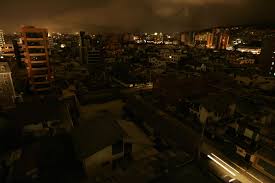Mazar reservoir decline, low output from Coca Codo, and Colombia’s energy export risks heighten blackout threats.
Ecuador is on the brink of significant power outages due to a combination of factors, including a steep decline in the Mazar reservoir, reduced electricity generation from Coca Codo Sinclair, and the possibility that Colombia may suspend its energy exports.
Experts are warning that if preventive blackouts don’t start soon, Ecuador could face power cuts lasting more than four hours a day.
The government is racing against time to prevent widespread blackouts, especially with the drought expected to worsen in mid-August. According to experts, the current drought classification is “severe.” If these conditions persist, blackouts could begin before the end of September.
Those same experts are suggesting that power rationing should already be underway.
Drought Impact in Southern Ecuador
The southern region of Ecuador, particularly the city of Cuenca, has been hardest hit by the drought. The rivers that feed into the Paute reservoir, crucial for the country’s power supply, have seen minimal rainfall for 55 days. This was reported by the Municipal Public Company for Telecommunications, Drinking Water, Sanitation, and Environmental Management (Etapa) on Thursday, September 5th.
The Mazar reservoir, which is essential for Ecuador’s energy generation, is losing about one meter of water per day.
For example, between 2:00 PM on September 4 and the same time on September 5, the water level dropped by 1.60 meters—from 2,136.19 meters above sea level to 2,134.59 meters—according to data from the National Electric Corporation (CELEC).
Energy Generation at Risk
Marco Acuña, president of the College of Electrical Engineers, explained that the water levels at Mazar—Ecuador’s second-largest reservoir—are critical because they directly affect the electricity supply from the Paute, Mazar, and Sopladora hydroelectric plants.
These plants rely on both national energy generation and imports from Colombia.
Although the government has declared a state of emergency in the electricity sector and is conducting tenders to acquire 750 megawatts (MW) of energy, the situation remains dire. The delayed arrival of 100 MW from a Turkish power barge in Guayaquil, combined with limitations on electricity imports from Colombia and the severity of the drought, means blackouts could start before the end of September.
Andrés Oquendo, former president of the College of Electrical Engineers, described the drought as “severe” and noted a broader issue in Ecuador’s national electrical system.
Coca Codo Sinclair, the country’s largest hydroelectric plant, is operating at less than full capacity. Normally producing 1,500 MW, it is only generating 700–800 MW due to low flow in the Coca River, which is currently at 20.1 cubic meters per second. Sedimentation and regressive erosion in the river compound the issue.
Imminent Blackout Risks
Ecuador’s electricity demand remains high. On Thursday, September 5th, demand was 4,192.9 MW, though it tends to drop over weekends. Currently, the country’s thermoelectric plants are running at full capacity, while Coca Codo Sinclair meets peak demand hours.
Given these factors, the risk of blackouts is becoming increasingly imminent. Oquendo emphasized that power rationing should begin immediately to avoid cuts exceeding four hours per day, which would quickly drain the Mazar reservoir. He recommended rationing electricity for up to two hours during peak demand periods to slow the decline of Paute’s water levels. “The problem is already here, and there should already be blackouts,” he warned.
Adding to Ecuador’s challenges, Colombia is also facing drought conditions, reducing its ability to export electricity. As a result, Colombia has limited exports to Ecuador to thermal generation only and may completely suspend energy transfers if needed.
This would leave Ecuador in a critical situation, awaiting new energy sources that were requested before the emergency declaration. According to Energy Minister Antonio Gonçalves, this new energy supply could take up to two months to arrive.
Hydro Plant Output and the Deficit
As of Thursday, September 5, the generation output of Ecuador’s main hydroelectric plants, as reported by the National Electricity Operator (Cenace), was as follows:
- Coca Codo Sinclair: 24%
- Paute: 29%
- Mazar: 7%
- Agoyán-San Francisco: 6%
- Sopladora: 16%
Ecuador currently has a daily energy deficit of 350 MW, which is compensated by purchases from Colombia. However, if Coca Codo produces less electricity, this deficit increases, raising the need for more expensive energy imports.
Colombia’s electricity exports to Ecuador are capped at 450 MW, and the cost of this energy has surged. Currently, Ecuador pays around 30 cents per kilowatt-hour for Colombian electricity, compared to 16 cents before the restrictions.



Go nuclear for Gods Sake
Seems the new President is not doing enough – I wonder what he is doing all day. Looks like very very little.